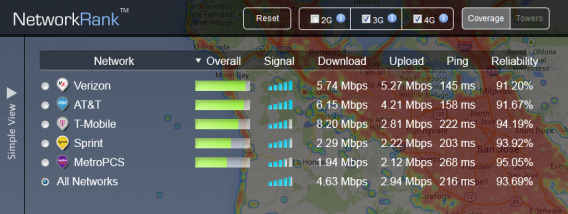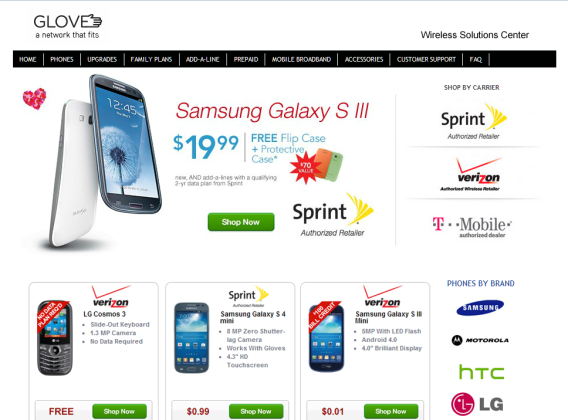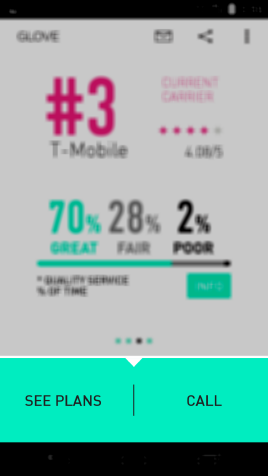From Glove’s description on the Google Play Store, it “Find[s] out which wireless carrier is best for YOU.” I used to use Verizon Wireless. Before I canceled my account, I had been a customer for about six years. My decision to switch wasn’t based on the network quality, but the type of network. Verizon’s network runs on CDMA, while AT&T and T-Mobile run on a GSM signal, which is more common worldwide.
Running the Glove app’s network test takes three days. Supposedly, it monitors the networks by using crowdsourced data around your location to find the best carrier. The first problem with Glove is that it’s not transparent. It doesn’t display any actual data tests. Instead, it shows you broad and generic messages saying Glove is “Comparing” networks and “Analyzing network quality in current location.”

Glove carrying out its analyses
When the test is finished, it shows the rankings of the different carriers and gives you the option to see their various cellphone plans or call them directly to change provider. When you actually want to look at plans, you’re sent to a Glove website offering plans from the three carriers it tests: Sprint, T-Mobile, and Verizon – all as an authorized retailer or reseller. I don’t know about you, but to me that makes the service and app look like very polished advertising. Regardless of the result, Glove, more specifically Glove Wireless, can offer you a new phone and wireless plan from all three of the carriers.
Tests are not transparent
Glove supposedly uses crowdsourced data when running its tests. But the question is, where is this data being pulled from? Glove doesn’t give much information, other than stating it’s comparing or analyzing, which could mean absolutely nothing. It runs a timer in the background, to give an impression of action, but the results it gives seem completely generic.

The results of a Glove analysis
Glove doesn’t tell us whether or not it supports tests when a person is using Wi-Fi rather than cell signal. With most plans having a data cap and lots of people using Wi-Fi at home and work, why doesn’t Glove monitor this usage?
More importantly, what kind of data is Glove pulling from the device? Why does Glove need to read my contacts for a test on my personal device?
When the test is over, Glove will show you the results of the three-day analysis. After running my test, these were the results I got:
- Sprint – 100% Great
- Verizon – 99% Great, 1% Fair
- T-Mobile – 70% Great, 28% Fair, 2% Poor
- AT&T 34% Great, 66% Fair
But let’s look at the data samples.
- Sprint – 9428 data samples
- Verizon – 10326 data samples
- T-Mobile – 13319 data samples
- AT&T – 15902 data samples
Verizon and AT&T are the two biggest cell carriers in the United States. T-Mobile is the upstart which has been changing the way cell plans are proposed.
Looking at the data through, while Sprint was number one, its network isn’t as congested as other companies. Just look at the “data samples.” Providers with worse rankings have more data samples, skewing the data. Glove should pull an identical number of samples from each carrier to find its results.
In general, taking a sample is only a small selection of data and more theoretical than concrete. Since Glove doesn’t reveal its specific comparison methodology, how can you trust the results?
According to NetworkRank, the results from Glove are misleading. Since NetworkRank actually provides specific data, you’ll get a much better perspective on the quality of networks.

OpenSignal’s NetworkRank provides more data (removed 2G connections from results)
Polished adware
After the test is complete and you’ve browsed the results, if you decide to switch you can browse plans or call to “get an offer from your best carrier.” What it doesn’t tell you is that both the ‘See Plans’ and ‘Call’ are redirects to Glove Wireless. The website Glovewireless.com is a landing page for http://www.cellstores.com/mobile/?r=glove.

Glove is also a mobile reseller
Any plan or upgrade is serviced through this authorized reseller/retailer. This means that you’re not getting service directly from the respective cell carrier and are actually being “assisted” by a third party.
When you reach the landing page for Glove’s reseller site, they offer more services, like prepaid plans from other carriers like Cricket Wireless and Boost Mobile. Essentially, the app leads you to believe that the tests will help you get better service, but Glove’s business model is to get you to buy a new plan so the company can get its profit from the cell carrier.
Research a better deal yourself
 Glove may state that it “helps you,” but it doesn’t provide enough statistical data to give you an accurate comparison of the four major carriers. A better bet is to look at cell coverage in your area and look at actual sourced data showing quality results. Even in San Francisco, there are small pockets where all networks suffer from patchy service.
Glove may state that it “helps you,” but it doesn’t provide enough statistical data to give you an accurate comparison of the four major carriers. A better bet is to look at cell coverage in your area and look at actual sourced data showing quality results. Even in San Francisco, there are small pockets where all networks suffer from patchy service.
From my own experience, Verizon was a strong carrier in the San Francisco area, but limited firmware updates to my devices, the limited CDMA network, and expensive carrier plans made me switch. I changed from my Samsung Galaxy S3 to T-Mobile and an unlocked Nexus 5.
The fact that T-Mobile and AT&T run the more common GSM cell network lets me travel and use the same phone. Also, buying a non-branded phone allows me to get firmware updates much quicker than waiting for the long cell carrier certification process.
Regardless of how you use your phone, you’ll always have options to change your carrier and get better service. Glove, however, might not be the best way to do that.


